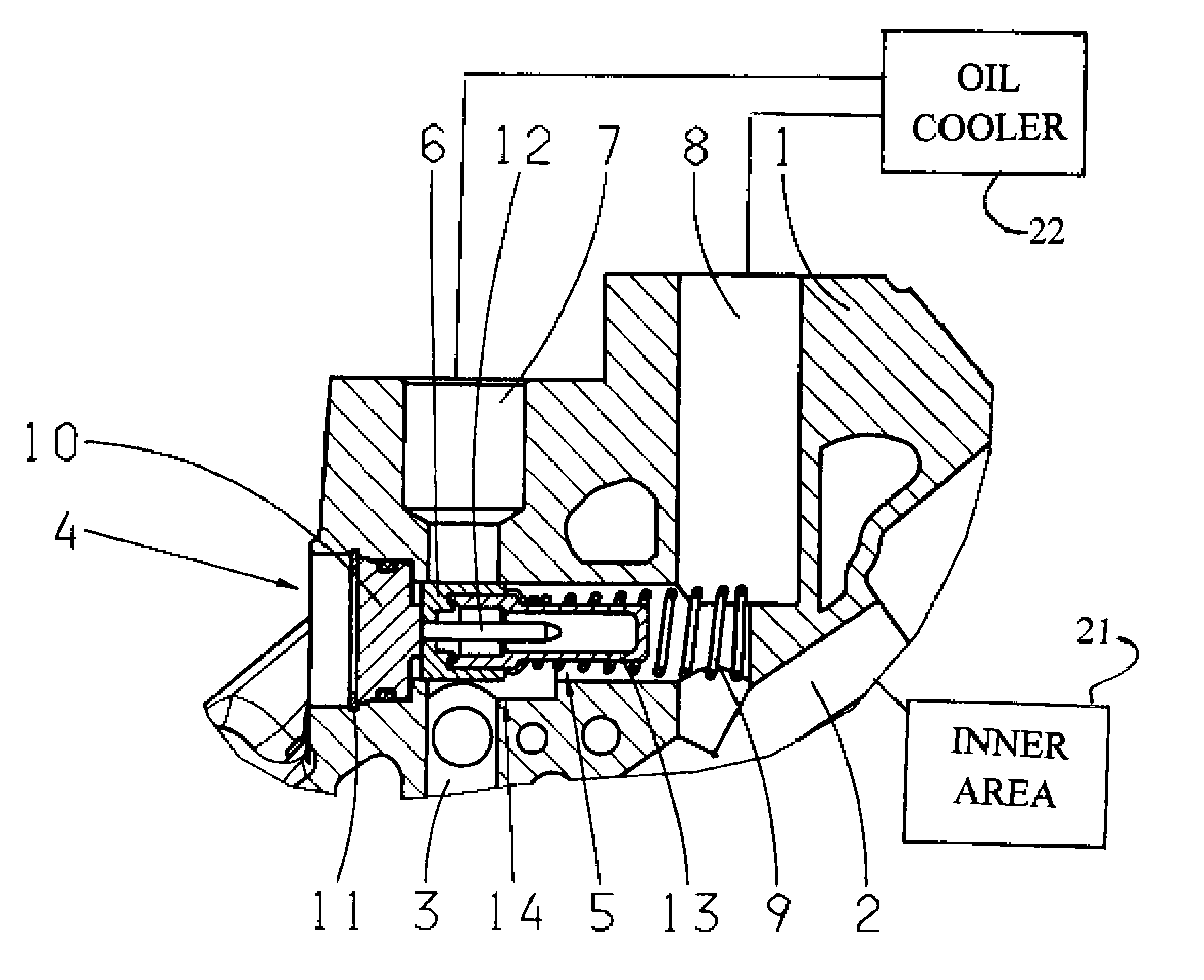Cooling oil circulation of a motor-vehicle transmission with a control valve
a technology of control valve and transmission oil, which is applied in the direction of gearing details, belts/chains/gear parts, gear lubrication/cooling, etc., can solve the problems of increasing the space in this area, not sufficiently dissipating the existing heat of the transmission oil, and increasing the production cost, so as to reduce the space requirements and reduce the manufacturing cost.
- Summary
- Abstract
- Description
- Claims
- Application Information
AI Technical Summary
Benefits of technology
Problems solved by technology
Method used
Image
Examples
first embodiment
[0027]In FIG. 1, a perspective view of the invented oil cooling circulation can be seen, in accordance with the first embodiment, in the area of a transmission housing 1 in which a input pipeline 2 and a return pipeline 3 are presented, to connect an inner area 21 with an oil cooler 22. A control valve 5 has been placed in the borehole 4 of the transmission enclosure 1, which connects the input pipeline and the output pipeline 2 and 3, according to the position of a valve part 6, with an inlet 7 and an outlet 8 of the oil cooler, to control the amount of transmission oil supplied into the oil cooler. By a return spring 9, this valve part 6 is preloaded against a support part 10, which is secured in the borehole 4 by a snap ring 11 and has, on its side facing the return pipeline 3, a pin-shaped top part in form of a thermostatic work part 12. Depending on its temperature, this thermostatic work part 12 changes its length and hereby initiates the related sliding of the valve part 6. T...
second embodiment
[0029]FIG. 2 shows a perspective partial view of the invented oil cooling circulation in accordance with a Different from the presented variation in FIG. 1, the inlet 7′ out the oil cooler is positioned at the front side of the valve part 6 and in the estuary of the borehole 4. Hereby, on the other side of the control valve 5 a continuation of the return pipeline 3 is closed by a plug 15. To enable a flow of the transmission oil now into the inlet 7′ of the oil cooler, the support part 10′ is constructed as in FIG. 3. One can recognize that in FIG. 3 the support part 10′ has a circular shaped part 16 with a bar 17, which extends through the centerline of the circular shaped part 16 and hereby defines two openings 18A and 18B. This bar 17 also has, in the axial direction, a bent design and has one receptacle 19, on the centerline of the circular shaped part 16, which is positioned for a contact with the thermostatic work part 12, not shown here.
third embodiment
[0030]FIG. 4 presents a detailed sectional view of the invented oil cooling circulation, in accordance with a third embodiment and presented in the area of the control valve 5. Different from the two previously described embodiments, the circular shaped part 16′ has an axial extension through which the borehole cross section of the return pipeline 3 becomes partially closed and through which an oil stream is reduced, when coupled with the inlet 7′ of the oil cooler.
PUM
 Login to View More
Login to View More Abstract
Description
Claims
Application Information
 Login to View More
Login to View More - R&D
- Intellectual Property
- Life Sciences
- Materials
- Tech Scout
- Unparalleled Data Quality
- Higher Quality Content
- 60% Fewer Hallucinations
Browse by: Latest US Patents, China's latest patents, Technical Efficacy Thesaurus, Application Domain, Technology Topic, Popular Technical Reports.
© 2025 PatSnap. All rights reserved.Legal|Privacy policy|Modern Slavery Act Transparency Statement|Sitemap|About US| Contact US: help@patsnap.com



